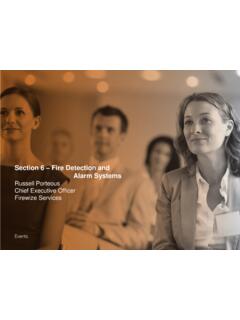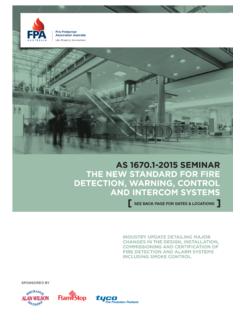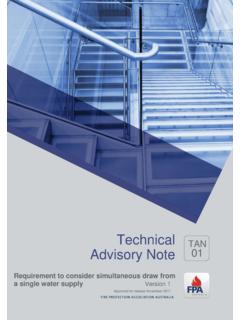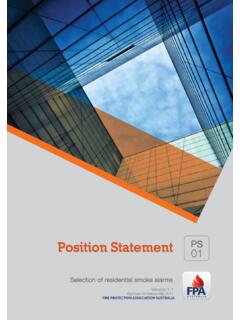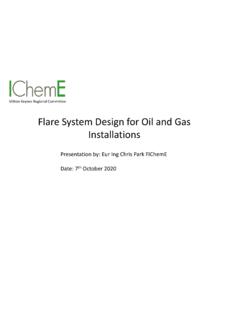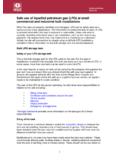Transcription of AS 2419.1-2005 Fire hydrant installations - System design ...
1 AS 2005 (Incorporating Amendment No. 1) Australian Standard Fire hydrant installations Part 1: System design , installation and commissioning AS 2005 Reproduced by the FPAA [Licensee] under licence CL0610fpa by Standards Australia Limited. The Licensee may reproduce this document in accordance with the licence. Any further reproduction is strictly prohibited. All copies of this document must be obtained from the Licensee. Should the end-user be interested in reproducing any content of this document please contact Standards Australia via This Australian Standard was prepared by Committee FP-009, Fire hydrant installations . It was approved on behalf of the Council of Standards Australia on 20 October 2005. This Standard was published on 26 November 2005. The following are represented on Committee FP-009: Association of Hydraulic Services Consultants Australia Australasian Fire Authorities Council Australian Building Codes Board Certification Interests (Australia) Copper Development Centre Australia Department of Defence (Australia) Fire Protection Association Australia Institution of Engineers Australia Plastics Industry Pipe Association of Australia Property Council of Australia Water Services Association of Australia This Standard was issued in draft form for comment as DR 03223.
2 Standards Australia wishes to acknowledge the participation of the expert individuals that contributed to the development of this Standard through their representation on the Committee and through public comment period. Keeping Standards upKeeping Standards upKeeping Standards upKeeping Standards up----totototo----datedatedatedate Australian Standards are living documents that reflect progress in science, technology and systems. To maintain their currency, all Standards are periodically reviewed, and new editions are published. Between editions, amendments may be issued. Standards may also be withdrawn. It is important that readers assure themselves they are using a current Standard, which should include any amendments that may have been published since the Standard was published. Detailed information about Australian Standards, drafts, amendments and new projects can be found by visiting Standards Australia welcomes suggestions for improvements, and encourages readers to notify us immediately of any apparent inaccuracies or ambiguities.
3 Contact us via email at or write to Standards Australia, GPO Box 476, Sydney, NSW 2001. FPAA reproduced with the permission of Standards Australia under licence CL0610fpa AS 2005 (Incorporating Amendment No. 1) Australian Standard Fire hydrant installations Part 1: System design , installation and commissioning Originated as AS 2419 1980. Revised and redesignated AS 1988. Fourth edition 2005. Reissued incorporating Amendment No. 1 (June 2007). COPYRIGHT Standards Australia All rights are reserved. No part of this work may be reproduced or copied in any form or by any means, electronic or mechanical, including photocopying, without the writtenpermission of the publisher. Published by Standards Australia GPO Box 476, Sydney, NSW 2001, Australia ISBN 0 7337 7010 X FPAA reproduced with the permission of Standards Australia under licence CL0610fpaAS 2005 2 PREFACE This Standard was prepared by the Standards Australia Committee FP-009, Fire hydrant installations , to supersede AS 1994.
4 This Standard incorporates Amendment No. 1 (June 2007). The changes required by the Amendment are indicated in the text by a marginal bar and amendment number against the clause, note, table, figure or part thereof affected. The changes to the previous edition of this Standard comprise the following: (a) A stated objective. (b) Clarification of intent. (c) A restructure of the document into more user friendly equipment-specific sections. (d) Incorporation of all revisions contained in Amendment No. 1, which expanded the requirements for fire hydrant System design , acceptable sources of water supply, water supply capacities and general revisions to account for advances in technology for materials, methods of installation and firefighting requirements. (e) Inclusion of a commentary to some clauses. This Standard will be referenced in the Building Code of Australia 2006; thereby superseding AS 1994, which will be withdrawn 12 months from the date of publication of this Standard.
5 Commentary is for information only and does not need to be followed for compliance with the Standard. Notes to the text contain information and guidance. They are not an integral part of the Standard. Illustrations in this Standard are purely diagrammatic and are intended to show functional requirements only, not methods of construction. The terms normative and informative have been used in this Standard to define the application of the Appendix to which they apply. A normative Appendix is an integral part of a Standard, whereas an informative Appendix is only for information and guidance. FPAA reproduced with the permission of Standards Australia under licence CL0610fpa 3 AS 2005 CONTENTS Page 5 SECTION 1 SCOPE AND GENERAL SCOPE .. 6 6 NORMATIVE 6 DEFINITIONS.
6 6 SYMBOLS .. 8 SECTION 2 System design design 9 design 10 REQUIRED System 11 SECTION 3 LOCATION AND OTHER PROVISIONS GENERAL .. 15 LOCATION OF ON-SITE FIRE HYDRANTS .. 15 OPEN YARD PROTECTION .. 22 23 FIRE hydrant ACCESSIBILITY AND 23 FIRE hydrant CABINETS, ENCLOSURES OR 25 SECTION 4 WATER SUPPLIES ACCEPTABLE SOURCES OF WATER 26 MINIMUM WATER SUPPLY 26 ON-SITE WATER 26 SECTION 5 WATER STORAGE GENERAL .. 28 WATER SUPPLIES TO STORAGE TANKS .. 28 EFFECTIVE 29 STORAGE TANK CONNECTIONS, VALVES AND 32 SECTION 6 PUMPSETS GENERAL .. 38 PUMPSET 38 ELECTRIC DRIVER ISOLATING SWITCHES .. 38 PUMPROOM .. 38 SECTION 7 FIRE BRIGADE BOOSTER ASSEMBLY GENERAL .. 40 WHEN A BOOSTER ASSEMBLY IS 40 40 FIRE BRIGADE BOOSTER ASSEMBLY 43 BOOSTER IN PARALLEL WITH 47 BOOSTERS IN SERIES (RELAY) WITH PUMPS.
7 47 FIRE BRIGADE RELAY PUMPS .. 49 FIRE BRIGADE BOOSTER ASSEMBLY 49 FIRE BRIGADE BOOSTER ASSEMBLY CABINET OR ENCLOSURE 50 FPAA reproduced with the permission of Standards Australia under licence CL0610fpaAS 2005 4 SIGNAGE .. 50 BLOCK PLAN .. 51 SECTION 8 PIPEWORK AND VALVES PIPES, VALVES AND FITTINGS .. 55 PIPE AND PIPE FITTING SPECIFICATIONS .. 55 METAL PIPE JOINTS .. 57 HYDROSTATIC PRESSURE 58 PIPEWORK design .. 58 System PROTECTION AND 63 SUPPORT OF FIRE hydrant PIPEWORK .. 65 THRUST BLOCKS AND ANCHORS .. 68 SECTION 9 ANCILLARY EQUIPMENT GENERAL .. 69 FIRE HOSE .. 69 PRESSURE 69 BACKFLOW PREVENTION .. 70 SECTION 10 COMMISSIONING GENERAL .. 71 HYDROSTATIC 71 COMMISSIONING TESTS .. 71 SYSTEMS THAT INCORPORATE A BOOSTER .. 72 SYSTEMS THAT INCORPORATE A PUMP.
8 72 SYSTEMS THAT INCORPORATE A 72 RECORDING OF COMMISSIONING (VERIFICATION) 72 APPENDICES A NORMATIVE 74 B FIRE HYDRANTS IN ACCESSWAYS WITHIN A PRIVATE 76 C FIRE hydrant INSTALLATION WATER SUPPLY FLOW 77 D FIRE BRIGADE APPLIANCES AND 78 E DETAILS OF EQUIPMENT CONNECTED TO A FIRE hydrant .. 81 F DETERMINATION OF WATER System SUPPLY 83 G 89 H SPECIAL HAZARDS .. 90 FPAA reproduced with the permission of Standards Australia under licence CL0610fpa 5 AS 2005 FOREWORD The availability of fire hydrants is essential to fire protection. Fire hydrants may be used to control the spread of fire, protect neighbouring properties and extinguish an outbreak of fire, or extinguish a fire controlled by an automatic fire protection System , such as sprinkler, gaseous and foam systems. Although fire hydrants are installed within properties for use by the fire brigade, they may also be used by trained personnel.
9 An adequate source of water is a fundamental consideration in the design of a fire hydrant installation and may comprise water from more than one source. A source based on a 4 h duration at the flow rates given in this Standard is regarded as the minimum safe quantity to enable fire brigades to commence an initial attack to limit fire spread, protect neighbouring properties and extinguish the fire. Fire hydrant systems need to be regularly inspected, tested and maintained to ensure continued readiness for use. Where pump sets are installed, regular maintenance is essential. Fire brigade equipment and firefighting procedures may vary between and within states and should be considered in the fire hydrant System design . FPAA reproduced with the permission of Standards Australia under licence CL0610fpaAS 2005 6 Standards Australia STANDARDS AUSTRALIA Australian Standard Fire hydrant installations Part 1: System design , installation and commissioning SECTION 1 SCOPE AND GENERAL SCOPE This Standard sets out requirements for the design , installation, and commissioning of fire hydrant systems to protect properties.
10 It applies to fire hydrant systems installed to protect buildings, structures, storage yards, marinas and associated moored vessels, wharves, and plant. This Standard also applies to street fire hydrants used in lieu of on-site fire hydrants or to supplement the coverage afforded by street fire hydrants. This Standard does not apply to (but may be referenced during design for) the protection of special hazards such as flammable and combustible liquid installation (see Note 4). NOTES: 1 Requirements for maintenance of fire hydrant installations are given in AS 1851 (see Appendix G). 2 Appendix C sets out a flow chart for a fire hydrant System design based on the type and capability of the water supply. 3 Hose couplings and the regions in which they are used in Australia are given in Appendix E. 4 General guidance for fire hydrant installations in special hazard areas is given in Appendix H. OBJECTIVE The objective of this Standard is to specify minimum requirements for the design , installation and commissioning of fire hydrant systems which (a) will augment the efficient extinguishment of fire within the boundaries of the site; (b) can be utilized to minimize fire spread within or between one property or building and another; (c) can be used by trained firefighting personnel; and (d) are compatible with the local fire brigade s firefighting equipment.
